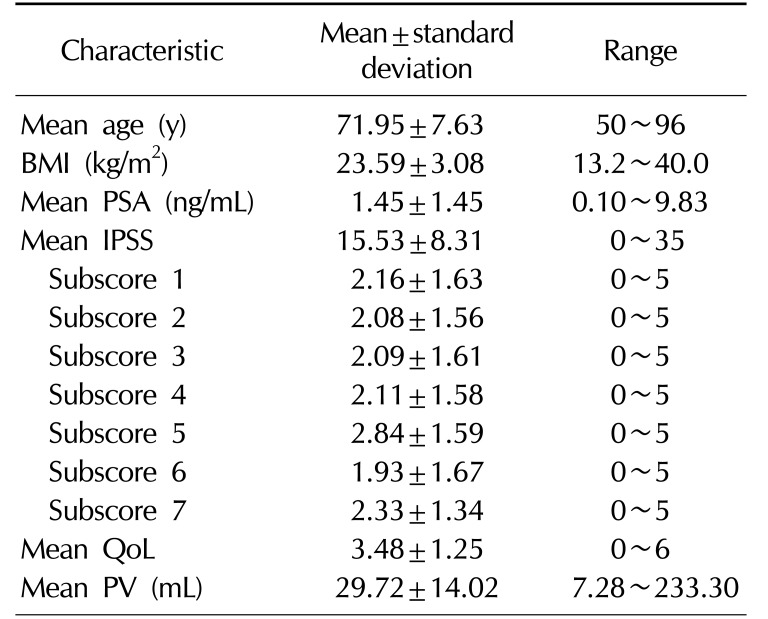1. Parikh NI, Pencina MJ, Wang TJ, Lanier KJ, Fox CS, D'Agostino RB, et al. Increasing trends in incidence of overweight and obesity over 5 decades. Am J Med. 2007; 120:242–250. PMID:
17349447.

2. Guh DP, Zhang W, Bansback N, Amarsi Z, Birmingham CL, Anis AH. The incidence of co-morbidities related to obesity and overweight: a systematic review and meta-analysis. BMC Public Health. 2009; 9:88. PMID:
19320986.

3. Faith MS, Butryn M, Wadden TA, Fabricatore A, Nguyen AM, Heymsfield SB. Evidence for prospective associations among depression and obesity in population-based studies. Obes Rev. 2011; 12:e438–e453. PMID:
21414128.

4. Ananthapavan J, Sacks G, Moodie M, Carter R. Economics of obesity: learning from the past to contribute to a better future. Int J Environ Res Public Health. 2014; 11:4007–4025. PMID:
24736685.
5. Stamey TA, Yang N, Hay AR, McNeal JE, Freiha FS, Redwine E. Prostate-specific antigen as a serum marker for adenocarcinoma of the prostate. N Engl J Med. 1987; 317:909–916. PMID:
2442609.

6. Oesterling JE, Chan DW, Epstein JI, Kimball AW Jr, Bruzek DJ, Rock RC, et al. Prostate specific antigen in the preoperative and postoperative evaluation of localized prostatic cancer treated with radical prostatectomy. J Urol. 1988; 139:766–772. PMID:
2451037.

7. Krumholtz JS, Carvalhal GF, Ramos CG, Smith DS, Thorson P, Yan Y, et al. Prostate-specific antigen cutoff of 2.6 ng/mL for prostate cancer screening is associated with favorable pathologic tumor features. Urology. 2002; 60:469–473. discussion 473-4. PMID:
12350486.

8. Thompson IM, Pauler DK, Goodman PJ, Tangen CM, Lucia MS, Parnes HL, et al. Prevalence of prostate cancer among men with a prostate-specific antigen level < or =4.0 ng per milliliter. N Engl J Med. 2004; 350:2239–2246. PMID:
15163773.
9. Freedland SJ, Wen J, Wuerstle M, Shah A, Lai D, Moalej B, et al. Obesity is a significant risk factor for prostate cancer at the time of biopsy. Urology. 2008; 72:1102–1105. PMID:
18722650.

10. Pietrzyk B, Olszanecka-Glinianowicz M, Owczarek A, Gabryelewicz T, Almgren-Rachtan A, Prajsner A, et al. Depressive symptoms in patients diagnosed with benign prostatic hyperplasia. Int Urol Nephrol. 2015; 47:431–440. PMID:
25673555.

11. Parsons JK, Bergstrom J, Silberstein J, Barrett-Connor E. Prevalence and characteristics of lower urinary tract symptoms in men aged > or = 80 years. Urology. 2008; 72:318–321. PMID:
18554695.
12. Zhao S, Chen C, Chen Z, Xia M, Tang J, Shao S, et al. Relationship between metabolic syndrome and predictors for clinical benign prostatic hyperplasia progression and international prostate symptom score in patients with moderate to severe lower urinary tract symptoms. Urol J. 2016; 13:2717–2726. PMID:
27351328.
13. Kim GW, Doo SW, Yang WJ, Song YS. Effects of obesity on prostate volume and lower urinary tract symptoms in Korean men. Korean J Urol. 2010; 51:344–347. PMID:
20495698.

14. Clinical Guidelines on the Identification, Evaluation, and Treatment of Overweight and Obesity in Adults: The Evidence Report. National Institutes of Health. Obes Res. 1998; 6(Suppl 2):51S–209S. PMID:
9813653.
15. Thompson IM, Leach R, Troyer D, Pollock B, Naylor S, Higgins B. Relationship of body mass index and prostate specific antigen in a population-based study. Urol Oncol. 2004; 22:127–131. PMID:
15082010.

16. Fowke JH, Motley SS, Cookson MS, Concepcion R, Chang SS, Wills ML, et al. The association between body size, prostate volume and prostate-specific antigen. Prostate Cancer Prostatic Dis. 2007; 10:137–142. PMID:
17179979.

17. Lee RK, Chung D, Chughtai B, Te AE, Kaplan SA. Central obesity as measured by waist circumference is predictive of severity of lower urinary tract symptoms. BJU Int. 2012; 110:540–545. PMID:
22243806.

18. Jeong IG, Hwang SS, Kim HK, Ahn H, Kim CS. The association of metabolic syndrome and its components with serum prostate-specific antigen levels in a Korean-screened population. Cancer Epidemiol Biomarkers Prev. 2010; 19:371–380. PMID:
20086117.

19. Werny DM, Thompson T, Saraiya M, Freedman D, Kottiri BJ, German RR, et al. Obesity is negatively associated with prostate-specific antigen in U.S. men, 2001-2004. Cancer Epidemiol Biomarkers Prev. 2007; 16:70–76. PMID:
17179487.

20. Freedland SJ, Platz EA, Presti JC Jr, Aronson WJ, Amling CL, Kane CJ, et al. Obesity, serum prostate specific antigen and prostate size: implications for prostate cancer detection. J Urol. 2006; 175:500–504. discussion 504. PMID:
16406980.

21. Bañez LL, Hamilton RJ, Partin AW, Vollmer RT, Sun L, Rodriguez C, et al. Obesity-related plasma hemodilution and PSA concentration among men with prostate cancer. JAMA. 2007; 298:2275–2280. PMID:
18029831.

22. Wright ME, Chang SC, Schatzkin A, Albanes D, Kipnis V, Mouw T, et al. Prospective study of adiposity and weight change in relation to prostate cancer incidence and mortality. Cancer. 2007; 109:675–684. PMID:
17211863.

23. Hekal IA, Ibrahiem EI. Obesity-PSA relationship: a new formula. Prostate Cancer Prostatic Dis. 2010; 13:186–190. PMID:
20029402.

24. Haidinger G, Temml C, Schatzl G, Brössner C, Roehlich M, Schmidbauer CP, et al. Risk factors for lower urinary tract symptoms in elderly men. For the Prostate Study Group of the Austrian Society of Urology. Eur Urol. 2000; 37:413–420. PMID:
10765071.
25. Yee CH, So WY, Yip SK, Wu E, Yau P, Ng CF. Effect of weight reduction on the severity of lower urinary tract symptoms in obese male patients with benign prostatic hyperplasia: a randomized controlled trial. Korean J Urol. 2015; 56:240–246. discussion 246-7. PMID:
25763129.

26. Cyrus A, Kabir A, Goodarzi D, Talaei A, Moradi A, Rafiee M, et al. Impact of metabolic syndrome on response to medical treatment of benign prostatic hyperplasia. Korean J Urol. 2014; 55:814–820. PMID:
25512816.

27. Boyle P, Robertson C, Mazzetta C, Keech M, Hobbs R, Fourcade R, et al. The relationship between lower urinary tract symptoms and health status: the UREPIK study. BJU Int. 2003; 92:575–580. PMID:
14511037.

28. Perchon LF, Pintarelli VL, Bezerra E, Thiel M, Dambros M. Quality of life in elderly men with aging symptoms and lower urinary tract symptoms (LUTS). Neurourol Urodyn. 2011; 30:515–519. PMID:
21284026.

29. Pintarelli VL, Perchon LF, Lorenzetti F, Toniolo Neto J, Dambros M. Elderly men's quality of life and lower urinary tract symptoms: an intricate relationship. Int Braz J Urol. 2011; 37:758–765. PMID:
22234010.






